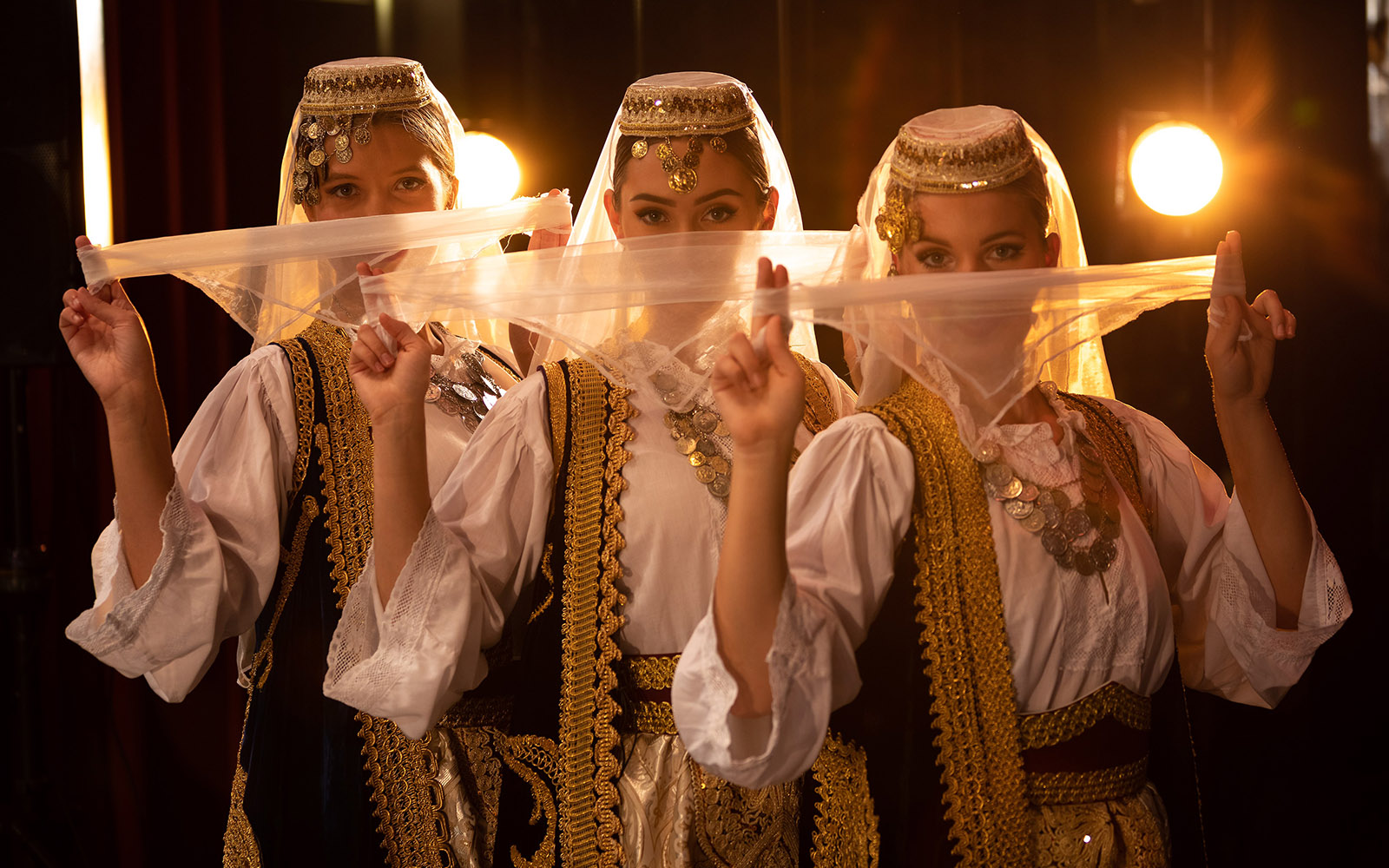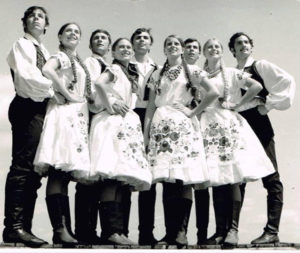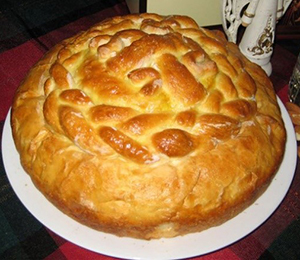
Three young women dressed for the Serbian Pembe dance. Image courtesy of The Tamburitzans.
By Brianna Horan, Manager of Tourism & Visitor Experience
Cultural Heritage Recipe Box: Serbian (and Italian!)

Tamburitzan Alumni
The Tamburitzans are a treasured folk ensemble that performs the live music and traditional dances of cultures from around the globe—all while calling Pittsburgh home. Founded in 1937 at Duquesne University, the ensemble takes its name from the tamburitza (or tamburica) family of stringed folk instruments that give traditional Eastern European music its distinctive sound. Today the Tamburitzans are an independent nonprofit organization open to Pittsburgh-based university students, and they are the longest-running multicultural song and dance company in the United States. They have traveled nationally and internationally to perform between 50 and 60 shows annually, showcasing an ever-expanding collection of ethnic songs and dance in authentic costumes. The Eastern European roots of the ensemble remain, and are complemented by Spanish, Bollywood, Middle Eastern, Irish, and a variety of other cultural traditions, which the Tamburitzans take care to represent respectfully.
The organization had been based in Uptown since the 1960s—the colorful, mosaic-like display of dancers and musicians on the rounded corner of their building is a recognizable landmark to those who travel on Boulevard of the Allies. While the COVID-19 pandemic has meant that the Tamburitzans’ 84th season has unfortunately had to be cancelled, the ensemble made a big move this year to a new headquarters in the former social hall of Holy Ghost Byzantine Catholic Church in the Northside. Their new building has the expanded space and facilities needed for rehearsals, social events, storage, technology and community events—and the façade is now emblazoned with a ring of dancers in colorful dresses.
The close-knit organization has grown in many ways over its long history, but celebrating and preserving ethnic traditions remains at its core. This mission and the experience of being a “Tammie,” as the Tamburitzans are affectionately known, has created close connections between current and former members of the ensemble. We’re glad to be able to share a collection of Christmas recipes and remembrances from active and alumni Tamburitzans which speak to their own personal heritage and traditions.
To learn more about the Tamburitzans, visit their website, call 412-224-2071, or email info@thetamburitzans.org. Follow them on social media: Facebook | Instagram | Twitter | YouTube. Find ways to support the organization by clicking here. And check out their Instagram teaser of the Tamburitzans dancing with the Carrie Blast Furnaces as a backdrop, which will be part of artist Andrea Stanislav’s upcoming installation and residency at the Mattress Factory museum.
From the kitchen of Millicent Novic

Millicent and Brad Novic
Millicent Novic, née Manolovich, performed with the Tamburitzans from 1969 to 1973. She and her husband Brad Novic met during that time when they were both Tammies, and they continue to be actively involved with the organization. Millicent and Brad’s daughter, Abbi Novic, was also a Tamburitzan, continuing their legacy.
“When asked to provide a recipe that evoked a fond memory, I immediately thought of the Christmas Eves we spent at my uncle’s farm in Monaca, PA. Every year my uncle (Bryan Savich) would invite all of his family members and friends to his farm to roast their pigs for their Christmas dinners the next day. With Tamburitzan music playing in the background, the whole day was filled with people preparing the animals by rubbing them down with plenty of garlic and salt and securing them on the spit to be placed in a large oven he had built at the far end of the party room in his house. Because the Serbian Orthodox people maintain a strict fast throughout the advent season and especially on Christmas Eve, my mother would prepare a Lenten meal for everyone to eat as they worked throughout the day. There was always a big pot of Lima Bean Potato Soup, Baccala (salted cod fried with garlic), Serbian Potato Salad made simply with onions, vinegar and oil, and Pogacha (crusty flat bread.) It was fun to listen to all the stories everyone would share, especially remembering how they all loved to eat this ‘Depression Food.’ The next day the abstinence of the fast made the first taste of pork especially delicious as you bit in and heard the crack of the salty crispy skin!
“Those were the days my friends, we thought they’d never end… Sadly, all of my older relatives have passed away, but not before they passed on their love for family, friends and heritage.
“In the same way, the Tamburitzans have kept the folk music of world cultures alive for over 84 years. It is through the love of those traditions that they perpetuate the rich cultural heritages of the countries they represent as a living tribute to our immigrant ancestors who came to this great nation in search of a better life. These traditions have been passed onto the next generation by awarding scholarships to the talented student-performers who are a part of the ensemble as the Tamburitzans continue to be an integral part of the fabric of Pittsburgh’s Arts community.” – Millicent Novic
Baby Lima Bean Soup
Ingredients
- 1 lb. baby lima beans, dried
- 1 cup barley
- 1 carrot
- 1 medium onion, chopped
- 1 stalk celery, chopped
- 1 clove garlic, diced
- 3 qts. water
- 4 medium potatoes, diced
- salt & pepper to taste
- 1 tsp. paprika
- 1/3 cup oil
- 2 Tbsp. flour
Instructions
Soak beans and barley separately overnight. Rinse well.
Place beans, barley and vegetables in 3 quarts of water and cook for 1 hour.
Add potatoes and cook until tender.
To make the zafrik (roux), heat oil and add flour, stirring until lightly browned. Add to soup. Simmer about 15 minutes until soup thickens.
Check for seasonings. Serve hot w/ ½ t. of vinegar added to your bowl of soup, if you like.
From the kitchen of Elaine Vucelich

Tearing the bread, photo courtesy of the Vucelich family.
This recipe is from the kitchen of Elaine Vucelich, a former administrator and business manager for the Tamburitzans. Her son, daughter, and son-in-law are all Tamburitzan alumni.
“I remember my mother baking this Cesnica (pronounced “Chesnitza”) every Christmas Eve (January 6). It is customary to abstain from meat and dairy on this day. The smell of fresh Cesnica throughout the house was hard for us kids because we knew that we couldn’t have any and that we had to wait until Christmas Day.
“Cesnica is never cut with a knife. It is customary that each member of the family breaks off a piece of the Cesnica, and the person who finds the coin in his portion will be the recipient of good fortune in the new year. I carry on this tradition still today with my children. Everyone gathers around and grabs a piece of the Cesnica with their right hand and we break it together – anxiously awaiting to see who will get the coin and good luck for the new year!” – Elaine Vucelich
Cesnica (Serbian Christmas Coin Bread)

Cesnica
Ingredients
- 1 pkg dry yeast
- ½ cup warm water
- 2 eggs beaten
- 1 tsp. salt
- 1 stick butter, softened
- 1 ½ cups warm milk
- 5 ½ cups flour
- 1 clean silver coin
Instructions
Dissolve yeast in ½ cup of warm water in a large bowl. Let sit a few minutes to activate.
Add eggs, salt, butter and milk beating well until thoroughly blended. Gradually add flour.
Knead dough until elastic like and smooth (Approx. 15 minutes). Place dough in greased bowl and turn to grease the top and bottom sides of dough. Cover with a cloth and let rise until double in size.
Punch down and knead again a few minutes. Insert the coin into the dough, shape the dough into a ball and place it on a greased round pizza pan or cookie sheet – flatten the ball. Let rise 1 hour. Bake at 350 degrees for 45-60 minutes – until golden brown.
From the kitchen of Sam and Sofia Caloiero

Sofia and Sam Caloiero
Twins Sam and Sofia Caloiero are freshmen performers with the Tamburitzans. Sam attends the Community College of Allegheny County, and Sofia attends Chatham University. When the pandemic started, they were seniors at North Hills High School. They used the extra time at home to start an educational cooking show with their dad, a producer and cameraman for WQED Multimedia. Read a Pittsburgh Post-Gazette article about that project, called “Family Style,” by clicking here, and watch their videos in WQED’s online education portal.
“For my sister and I to be Tamburitzans means embracing the culture of our family by performing traditional song and dance, and making our ancestors proud by introducing that culture to others.” – Sam Caloiero
“This dish, ‘Arancini,’ is a common dish in Italy that our Nonna brought to America with her family, and that she now calls ‘Rice Meatballs.’ Any time that I think of Christmas at Nonna’s house I automatically think of Rice Meatballs. I am so excited to have them because we only have them on the holidays.” – Sofia Caloiero
Arancini di Riso (“Rice Meatballs”)

Nonna Caloiero, Christmas 2019
Ingredients
- 2 cups rice – arborio or carnaroli
- 4-6 cups water or unsalted chicken broth
- Saffron for color, a few pinches (tomato puree can also be added for color if desired)
- Salt and seasoning to taste
- 2 cups flour – for dredging rice meatballs
- 10 cups seasoned bread crumbs – ground very fine
- 48 oz. (1 pint) vegetable oil for frying – corn oil or canola oil will also work
- Approximately 1-2 hours for prep/cook/cleanup
- Yields about 2 dozen rice meatballs
Instructions
Cook the rice in water or chicken stock, add the saffron or tomato puree for some color.
When rice is cooked, spread out on a cookie pan to cool.
Roll rice into balls to desired size, something a bit smaller than a tennis ball is good.
Roll the rice balls across some flour, covering the entire ball. You can add some water to flour to make a thin wet paste. Bread crumbs will stick to that better.
(Side note, you can add a small meatball, or cube of mozzarella in center of rice meatball for fun)
Roll the rice meatball through the bread crumbs getting even coverage, and shake off any extra bread crumbs.
Fry the rice meatballs in the oil.
Enjoy eating with family and friends. You can make a side red sauce for dipping!

The process of making rice meatballs. Photo courtesy of the Caloiero family.

Caloiero dinner table, Christmas 2019.







